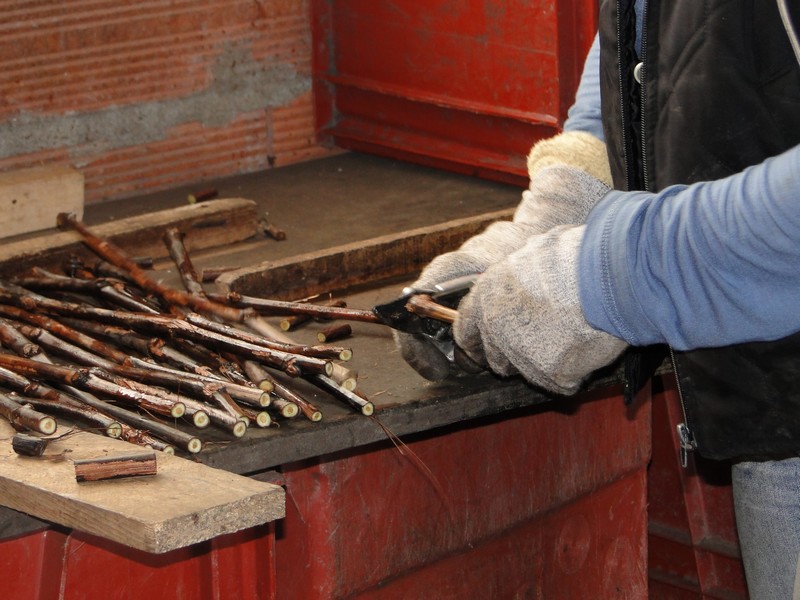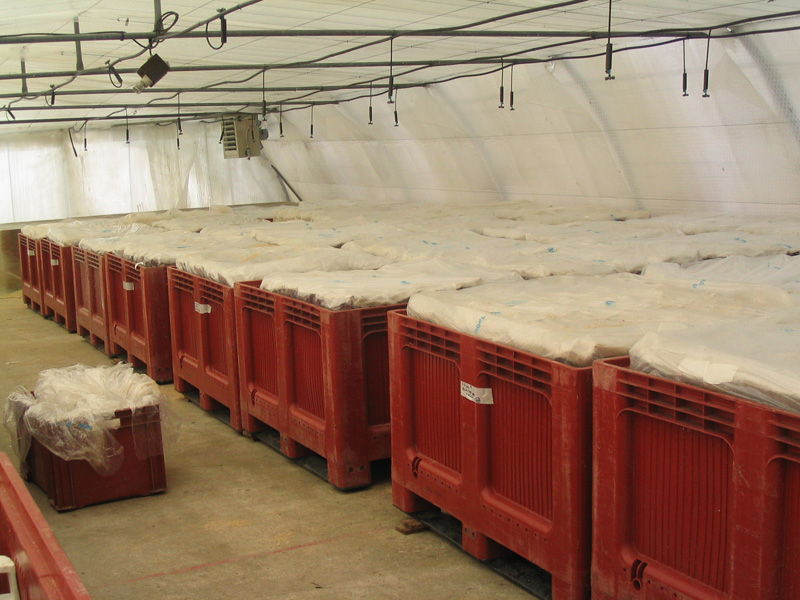Removal

After the first cold weather, the potted plants can begin to be removed from the nursery.
Our teams take the greatest care when removing traditional plants with bare roots from the soil, so that they can be sorted and packed.
This operation requires the greatest attention and coordination to ensure efficient work in the respect of the assemblages.
Once the potted plants have been removed, the plant batches are taken to the triage workshop where some 40 hands will sort them one by one.
Triage is a crucial and long process, because each plant must be inspected and tested according to precise qualitative criteria (grafts, root development, etc.)
The plants are then counted, wrapped with paraffin and labelled with certificates from the Contrôle sanitaire.
Potted plants in bags are stored in cold rooms.
Preparation of vegetal material


Stock: variety resistant to phylloxera
They are received in one-metre long bundles.
Depending on the production objectives, we select the wood, one by one, according to the various dimensions: 30cm, 45cm, 60cm, 70cm.
To avoid dehydration, we store the wood in cold rooms at a temperature of 5°c, with a saturated hygrometry (95%). The preparation of this vegetal material heralds the imminent start of the grafting.
Grafts : Variety of vitis vinifera grape
Thanks to our 10-hectare park of mother vines for grafting, we collect the stems in bundles in January. These will then be prepared for the grafting operation.
Grafting

The machine prepares the parts and automatically adjusts the one or the other so as to be perfectly symmetrical.
This operation is done on a table and consists in assembling the graft and the stock symmetrically with the help of the machines, which are manually operated by experts.
Paraffin and storage
The point of grafting is covered in paraffin (so that it won’t dry out) and the plants are stored in Palox boxes. These Palox are stored in a climate-controlled stratification chamber. The point of the grafting is then dipped in paraffin to ensure the hold of the assemblage and to avoid desiccation. The plants are then placed in boxes to be stored in the stratification chamber.
Stratification


The boxes are placed in stratification chambers where we maintain precise conditions of temperature and humidity in order to promote the development of the callus (the binding between the graft and the stock). This step is crucial to ensure the development of a quality plant.
The installation of a heating system allows us to maintain a constant temperature of 30°C.
The humidifiers and water system at the base of the boxes ensure optimal hygrometry for the development of the callus.
After successful stratification, the potted plants begin to bud.
Once this phase is completed, the potted plants are inspected, and only those plants are retained for which the grafting has been successful. These are given a new coat of paraffin.
This final process covers the callous with a layer of paraffin to protect against desiccation after the plants are replanted.
At this stage, the plants can either be planted in pots in a greenhouse or nursery.
Potted plants

Plants cultivated through stratification are positioned in biodegradable pots with special soil for vines.
The humidity, temperature and irrigation conditions inside our greenhouses promote optimal growth of these plants.
The pots are watered, trimmed and protected for cryptogamic disease several times before being sorted.
This sorting serves to differentiate the plants that are sufficiently developed from those that need to stay a bit longer in the greenhouses.
Placement in nursery


Plants in pots derived from stratification are removed from their containers and covered with paraffin in order to avoid drying out of the grafting point, then planted in nursery fields. These black-sand lands, fallow for minimum 5 years, have been enriched throughout the winter, with irrigation and perforated plastic mulching mounds set up by our teams.
The plants will be manually planted at a density of 25 plants per metre, scrupulously respecting the different assemblages.
From that moment, our nurseries will be monitored and cared for daily, in order to obtain plants worthy of our name.

